By Shaun Burke
When Daytona International Speedway opened in 1959, NASCAR introduced a race called the “Daytona 500 Qualifier”. This 40 lap race was won by Bob Welborn and paid $800 to the winner. More importantly, it gave Bob Welborn the pole for the first ever Daytona 500. In 1960, NASCAR held two of these qualifying races. We now know this race as the “Gatorade Dual 150s.”
Over the course of 50 years, this qualifying race has taken on several different names and formats. It started as simply a way to set the field. In fact, in the first race in 1959, only 38 drivers participated in the qualifying race while 59 took the green flag in the Daytona 500. Under its current format, the Gatorade Dual races not only set the starting position for the Daytona 500, but also determine who makes the race.
One of the most confusing things about speed weeks is how exactly the Gatorade Duals sets the field for the Daytona 500. I will attempt to explain how each position is set!
Position 1-2: The front row is set the Sunday before the Duals. The fastest two qualifiers are guaranteed to start first and second in the Daytona 500. They are also awarded the pole position for their respective Dual race. Many times, we will see these drivers race conservatively in the dual race because it does not matter where the finish in the race; however, if they crash the car, they will be forced to start at the rear in a backup car.
Position 3-39: This is where it gets confusing. Drivers who are currently in the top 35 in points already know which dual race they will be in. If your team finished in an odd number in the final 2010 owners points, you will be in race 1. If your team finished in an even number, you will be in race 2. The only exception to this rule is the drivers who turned the top two speeds in qualifying. All the other drivers (teams not in the top 35) are then evenly split between the two races based on their qualifying times. For example, the fastest car not in the top 35 will race in race 1, the second fastest is in race 2, etc. This ranking is versus other teams outside the top 35, not the field. Now that we know which race each car will be in, the hard part is done!
The Dual lineup for each race is set based upon qualifying times. The easiest way to do this is separate each group (based on the criteria above) and look at qualifying speeds.
We now have our starting lineup for each Dual race; but that will be insignificant up by the time the field gets to turn one! What we really care about is how this race will set the field for the Daytona 500!
The first race determines the inside row for the Daytona 500 and the second race determines the outside row. The top 35 in owner’s points + the top two finishers of teams outside the top 35 (in their respective race) are locked in for the Daytona 500. For example, if Michael Waltrip, Joe Nemechek and Casey Mears finish 1-3 in their dual race (assuming they are in the same Dual race), Michael Waltrip and Joe Nemechek are guaranteed to start in positions 3 & 5 (assuming neither won the pole). Casey Mears would not start in the 3-39 group and would have to rely on his qualifying speed to make the race.
Position 40-42: These positions are simple: The fastest four drivers (from qualifying) that did not lock themselves in with the qualifying race. In the example above, if Casey Mears finished third in the Dual race, he was probably fast all week and had a qualifying speed to get him into the race (although starting from position 40 instead of 7). If not, he would miss the Daytona 500 despite finishing third in his Dual race!
Position 43: This position will go to either the most recent past champion not locked in by criteria 1-3 or the fifth fastest qualifier who did not make the Daytona 500 via their Dual race.
I hope that I have helped explain how the Daytona 500 qualifying format works in a manner that does not require an engineering degree!






